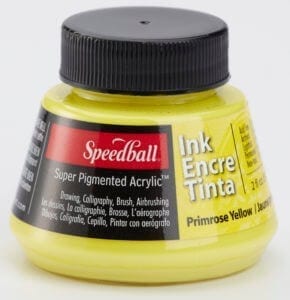


Crow quill pens have an itty-bitty nib, and if you pair those tiny nibs with thick inks, you can run into issues. First of all, I was very pleased at how nicely the ink worked with a crow quill pen. I mean, it does exactly what it’s supposed to do: it writes well and proves impervious to water.Ī couple of months ago, I used Bombay ink to create a line drawing of poppies, which I then painted over with watercolors. Martin’s Bombay India Ink, it’s a fantastic ink that you won’t regret having in your artillery. While I don’t think there is anything shout-it-to-the-rooftops special about Dr. It’s hard not to like India Inks in general they are smooth, waterproof, archival, and wonderful for illustration and calligraphy purposes. All of these inks are excellent choices if you wish to create black calligraphy however, it’s a good idea to get to know them a little bit better before you make a buying decision. Martin’s Bombay India Ink, Speedball India Ink, and Winsor & Newton Black Calligraphy Ink.

Today, we’re going to examine three more inks to conclude the comparison: Dr. I'm still fairly inexperienced and have avoided buying wood as I was always afraid I'd blow it up and waste the money, but I think I'm getting comfortable enough to purchase some wood for specific projects.In Part I of the Black Calligraphy Inks Comparison series, you were introduced to Ziller, Sumi, and Higgins inks. I just checked out their website and looks promising. Pod_box_comp.jpg blackwood_box_IMG_8158.jpgĪnother species that might look good with your piece is Bloodwood: I like to get both from Big Monk Lumber - I call up Pete and he sends out a box. That said, get some ebony for finials! Or african blackwood (it's a Dalbergia, a rosewood.) Both are a joy to turn and need no finish - just polish the bare wood. Holly is fine-grained and can take incredible detail AND takes the dye well. The preferred colorant is black leather dye. The preferred wood with some seems to be Holly. The pigment still lays on the surface like a stain and doesn't cover the wood uniformly. My experience has been a dark brown dye on light wood. The acid is how colonial long rifle builders treated the stocks they made. Chromic acid turns it a dark brown almost black, but depending on minerals in the wood, can turn the maple a funky dull dark greenish brown. Another trick is an acid treatment that works best on Maple, a weak nitric acid chemically changes the outer layer of wood to a sorrel color. I no longer do furniture, but still go through a small bottle of India ink every year. The wood grain still shows through slightly. It soaks into the wood a short distance compared to paint which lies on the surface. I also use red ink for some wooden stuff. I comes out looking more like a cheap oriental black lacquer than ebony, not quite as smooth and shiny. Back then Homer Formby stuff, but lately I use wipe on poly or (brush on) over top. (Utrecht, maybe) Stripped the old finish, sanded well, painted with India Ink and then a very very light sanding again.

(We used more than just black too) When I went on my own, I used the same stuff, mail ordered from a huge Art supply warehouse. The shop purchased india ink by the gallon. We used India ink on all kinds of pine furniture to make it look like ebony. I worked in a shop for about two weeks before that guy died and the job ended. Any recommendations on wood type to stain with india ink?ĭecades ago, I had a small side business buying, refinishing and then selling off bits of furniture. Are there certain types of india ink to buy or can I just get whatever Amazon sells? Do certain types of wood work better? I have a scrap of maple and sycamore that I could use, but don't have enough of either to test it out.


 0 kommentar(er)
0 kommentar(er)
